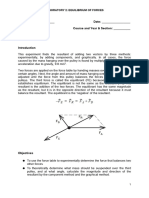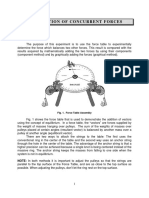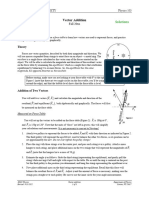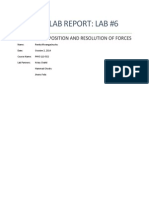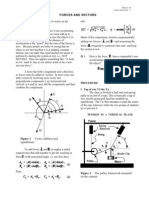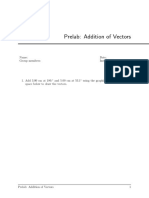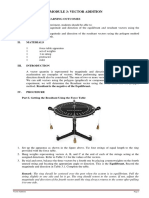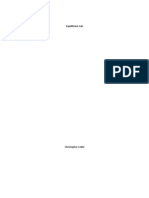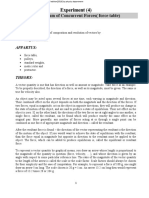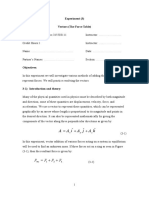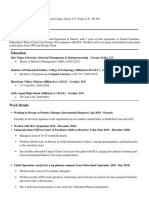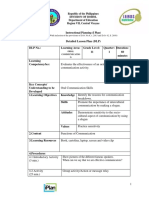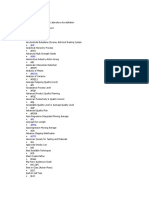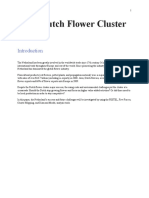Vector Addition
Vector Addition
Equipment Needed Equipment Needed
Super Pulley Force Table (ME-9447B) String (spool of thread)
Super Pulley Table Clamp (ME-9448B) Protractor
Mass and Hanger Set (ME-8979) Metric Ruler
Mass Balance (SE-8723) Sheet of paper (2)
Purpose
The purpose of this experiment is to use the force table to experimentally determine the force that balances two
other forces. This result is checked by adding the two forces using their horizontal and vertical vector components,
and by graphically adding the force vectors.
Theory
This experiment finds the resultant of adding two vectors by three methods: experimentally, by adding compo-
nents, and graphically
NOTE: In all cases, the force caused by the mass hanging over the pulley is found by multiplying the mass by the
acceleration due to gravity, 9.8 m/s2.
Experimental Method
Two forces are applied on the force table by handing masses over pulleys position at certain angles. Next, the
angle and amount of mass hanging over the third pulley are adjusted until the force from this pulley balances the
forces from the other two pulleys. The third force is called the equilibrant (FE) because it is the force that estab-
lishes equilibrium. The equilibrant is not the same as the resultant (FR). The resultant is the addition of the two
forces. The equilibrant has the same magnitude as the resultant, but it is in the opposite direction of the resultant
because it must balance the resultant. The equilibrant is the ‘negative’ of the resultant.
–F E = F R = F A + F B
FR
FB
FA
FE
Setup
1. Assemble the force table as shown in the Assembly section. Use three super pulley clamps (two for the
forces that will be added and one for the force that balances the sum of the other two forces).
2. Arrange the strings from the String Tie over the pulleys.
®
� 3. Hang the following masses over two of the super pulleys and clamp the pulleys at the given angles.
Table 1.1:
Force Mass Angle
FA 50 g (0.050 kg) 0°
FB 100 g (0.100 kg) 120°
FE
Procedure (Experimental Method)
By trial and error, find the angle for the third super pulley clamp and the mass that must be suspended over the pul-
ley so that its weight will balance the forces exerted on the strings by the other two masses. This third force is
called the equilibrant (FE) because it establishes equilibrium. The equilibrant is the negative of the resultant.
Record the mass and angle for the third pulley to put the system into equilibrium into Table 1.1.
To test whether the system is in equilibrium, use the following criteria.
Method of Finding Equilibrium
The clear disk will be centered in the String Tie when the system is in equilibrium. Pull the clear disk slightly to
one side and let it go. Check to see that the disk returns to the center. If not, adjust the mass and/or the angle of the
super pulley clamp until the disk always returns to the center when pulled slightly to one side.
Analysis
To theoretically determine what mass should be suspended over the third pulley, and at what angle, calculate the
magnitude and direction of the resultant by the component method and the graphical method. The equilibrant
(FE) will have the same magnitude, but it will be opposite in direction. In other words, the direction will be 180°
from the direction of the resultant.
Component Method
On a separate sheet of paper, add the vector components of Force A and Force B to determine the magnitude of the
equilibrant. Record the components Rx and Ry in Table 1.2. Use trigonometry to find the direction of the
equilibrant (remember, the equilibrant is exactly opposite in direction to the resultant.) Record the results in
Table 1.2.
Graphical Method
On a separate sheet of paper, construct a tail-to-head diagram of the vectors of Force A and Force B. Use a metric
ruler and protractor to measure the magnitude and direction of the resultant. Record the results in Table 1.2.
Remember to record the direction of the equilibrant as opposite in direction to the resultant..
Table 1.2:
Equilibrant (FE)
Method Magnitude Direction
Experimental
Component
Graphical
Rx = ______________ Ry = ______________
®
�Question
How do the theoretical values for the magnitude and direction of the equilibrant compare to the actual magnitude
and direction?
